|
|
Post by Dave on Aug 23, 2006 20:55:12 GMT -8
Five of us got together early this morning to head up Cheam in search of the Rock Ptarmigan. We had an awesome day, and saw well over 20 ptarmigan. 1 is possibly a Rock Ptarmigan. Before I explain this story, here are some pictures of White-tailed Ptarmigan to wet your appetite. 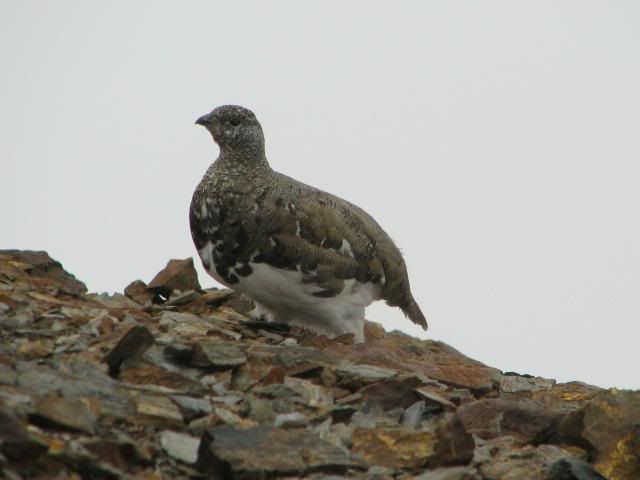 My first (life) White-tailed Ptarmigan. A nice male.  Another dude sitting on the edge of the cliff. 3 males were together an flew when a Goshawk appeared.  Classic female White-tailed. 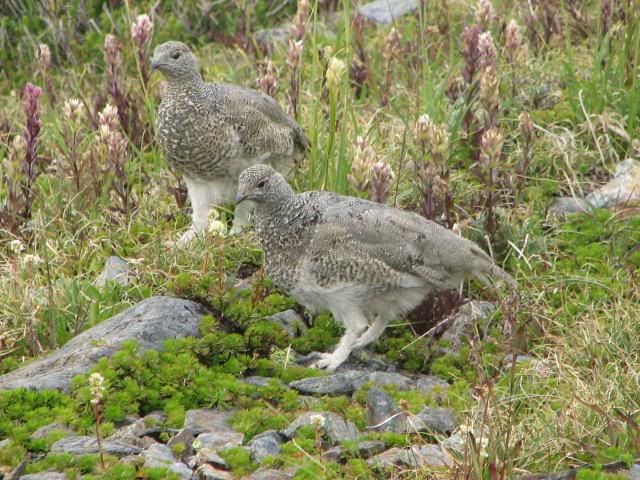 Young White-tailed chicks. Some walked right around me - within 12 inches of my boots! Now the story. The experienced Ptarmigan guys (Jeff and Gord) were off in the booneys getting lost in the fog when Thor, Tom and I spotted a group of Ptarmigan near the first crest of the Cheam ridge. We ID the group of about 4 as White-tailed. However, the group starting growing. It seemed as though Ptarmigans were coming from all sides! We radio'd Gord and Jeff (who eventually made it) and started sorting through the increasing mass of now about 15 birds. One larger bird entered the mess and started creating havoc - chasing at least two White-tailed hens. There where chickens all over, but Thor and I focused on the larger bird. At one point, the two involved in the chase/peck were half running/half flying and the wings and tail of the birds spread out. Thor and I both agree that the tail of the chaser had absolutely no white on it. I tried to focus on this bird to get pictures so we could have something to confirm our suspicions of a Rock Ptarmigan, especially without Jeff and Gord's assistance. Well, I started taking pictures of the bird which wandered in and out of all the others. I know that I took a few shots of that bird before it was lost in the mess of molting birds. The mess split up with a few birds going in each direction. We never found that bird again. All the ptarmigans were at different stages of molting, so every bird looked different! It was difficult to instantly ID anything. The chicks were pretty much full grown as well. Anyway, I have 121 pictures of Ptarmigan birds, now which one was the one we thought could be a Rock? Well......I went through the pictures and found a bird that appears to have the outside of its tail a dark colour, rather than bright white (See above white-tailed). What do you think? Is this agressive little guy a molting Rock Ptarmigan? 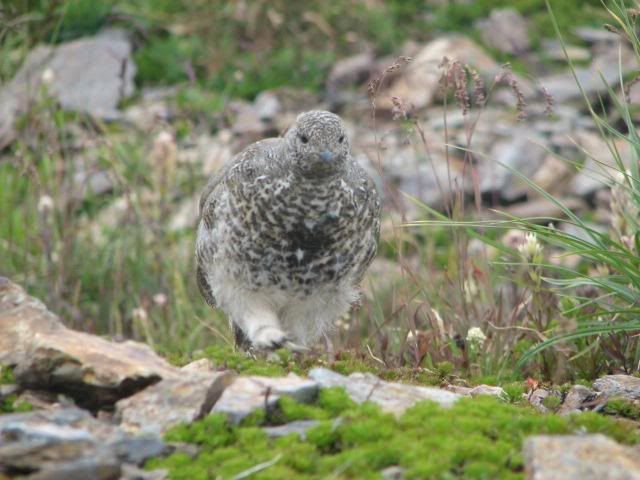 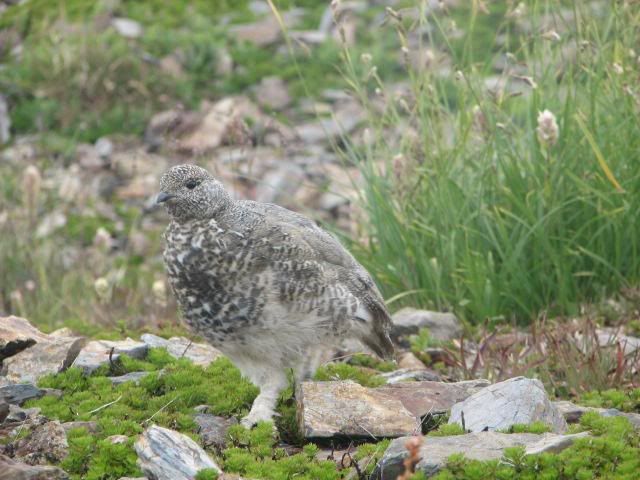   Let the critique begin! -Dave |
|
|
|
Post by Dave on Aug 23, 2006 21:15:42 GMT -8
I thought I would add these pictures that my brother Tom took of me getting pictures of Ptarmigans. It was getting comical as I would sit down on the side of the mountain top, and it seemed like the birds would just come right to me. No need for a fancy zoom feature. At one point, a ptarmigan was no more than 12 inches from my shoe. I hardly dared move. What an awesome experience - and don't forget, these are life birds for me  . Enjoy! 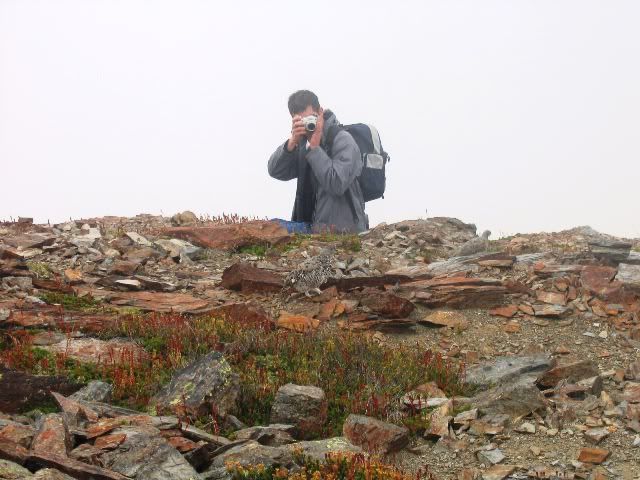  |
|
|
|
Post by Gord on Aug 24, 2006 8:27:26 GMT -8
Good pictures Dave!! I never saw this bird which to me, looks like a chick but almost full grown. Of course, this will compilcate matters even worse! Actually, I did see the bird Dave and Thor were watching through the mist and at a distance when I came down the trail while it chased an obvious white-tail. The bird in front (juv?) had white primaries and white tail while the chaser had white in the wings but no white was seen in the tail. After that some of the birds, including the promising looking one, snuck away and were not seen again.  Good work getting pictures, Dave! Comparing the bird in question with the obvious white-tailed chicks does seem to show different looking birds. You can see dark under the tail of the bird in question as well on both sides. The fact you dont see black all the way is the bird possibly is in moult/regrowing which makes sense if they moult in a symetrical pattern and the outside tail feathers are only visible and the uppertail coverts fills in the 'hole'. All the birds we saw, even some of the adults, appeared to be in moult and this included the tail in most of them, a huge diagnostic tool missing from many! Optimistically digging through that huge covey a couple birds only had uppertail coverts and a couple had really short/new white tail feathers just coming in and hard to see. I have a hard time going either way, but only because I only saw pictures and dont have the field observation time that Thor and Dave did which helps massively. Scared I missed a rock ptarmigan AND a goshawk! Two lifers, one of which has remained one for far too long. Ill post the species list and a few pictures as well when I get a chance. I dont want to wait on saying how an enjoyable time I had. What a great bunch of guys to go scrambing up the side of a mountain with to look at chickens!!!  |
|
|
|
Post by Dave on Aug 24, 2006 8:49:37 GMT -8
Good thoughts, Gord Once at home and looking at the bird on a bigger screeen, the colouring gave me the impression that this was a young bird. This makes me wonder if I have the right bird in the pictures here, as the one Thor and I saw was a bigger chicken. The biggest bird we saw that day in the mess, and I remember distinctly noticing chicks because they are a touch smaller - we clearly saw this when the hens and chicks split into various groups. What do you think, Thor? (Or are you off shopping for new pants??)  Dave |
|
|
|
Post by Dave on Aug 24, 2006 8:52:16 GMT -8
If anyone has the Audubon Society field guide to western birds, have a look at the Molting Rock Ptarmigan they have a picture of. (They have real pictures, sometimes helpful). Looks very close. The tail is very, very light (white even).
|
|
|
|
Post by tmanson on Aug 24, 2006 14:13:30 GMT -8
Dave, Gord, Jeff, and Fellow Birders: ( I think Tom has left the province ).
First of all, great pictures, as usual, Dave, and thanks to Gord for organizing the Cheam trip. It was worth a pair of old pants, which are now in the dumpster!!
It was quite a sight seeing all those Ptarmigan more or less together. I think we estimated the numbers at 20 plus.
As far as the id is concerned, it was definitely a challenge with the moulting birds, and most of the chicks almost fully grown.
In these kind of situations, to me, the best thing to do is concentrate on the features that don't change. I have two National Geographic Guides, Sibley, and the Audubon referred to above. We also have Dave's pictures, and a fairly good observation by Dave, and I as we had fairly lengthy looks at all the birds.
Unless someone knows differently, one thing that is consistent about White-tailed Ptarmigan is that they always have white tails during all seasons, including molts.
Similarly, one feature about Rock and Willow Ptarmigan is that they always have black on the outer part of the tail during all seasons, including molts
The bird that Dave and I saw was the biggest bird in the group, and as it was scrapping with a White-tail, flapping up, and down, we could clearly see the black on the tail, at close range.
Dave, whether the picture you are showing is of the exact bird we saw, I can't say for sure, but as far as I know, any Ptarmigan with a black tail will be a Willow, or a Rock.
I think we can eliminate Willow because of latitude, and the enviroment in which we saw it; ( bare rock outcroppings with sparse vegetation ). I think if we were up in Stone, or Pink Mountain in northern B.C., our challenge would be greater.
I know there are other birders who belong to this listserve, who may have experience with Ptarmigan, and I am sure the four of us would welcome any other opinions.
In the meantime, I don't mind going out on the proverbial limb, and say the bird Dave and I saw was a Rock Ptarmigan. Cheers, Thor
Thor Manson
Hope, B.C.
|
|
|
|
Post by Gord on Aug 24, 2006 14:21:55 GMT -8
Good work guys!! Although it breaks my heart to have basically missed it, Im really glad you guys got it. Seeing black in the flared tail as it chased that other bird cant be anything but! At my range, I could only see, as mentioned, white while black would have gone unnoticed against the ground. I guess technically Ive seen a rock ptarmigan as well although if I was by myself, I would never have been able to confirm it as it snuck off into the mist by the time I got closer.  Thor, that's the most ptarmigan Ive seen at one time too. So amazing to watch them do their thing as though we do not exist. I will post a species list and my pictures as well soon. Got a nice one of a hen white-tail who sat nicely. |
|
|
|
Post by Gord on Aug 24, 2006 15:01:15 GMT -8
Species List: MacGillvray's Warbler Wilson's Warbler Solitary Sandpiper Steller's Jay Golden-crowned Kinglet Band-tailed Pigeon Dark-eyed Junco Varied Thrush American Robin Black-throated Grey Warbler Golden Eagle adult Pine Siskin (flock of over 35 fly by. Nice to see once again!!!) Northern Flicker American Kestrel Yellow-rumped Warbler Winter Wren Grey Jay American Pipit Red-breasted Nuthatch Northern Goshawk imm White-tailed Ptarmigan (over 20 in one covey!) Rock Ptarmigan (1) Peregrine Falcon Mountain Chickadee Townsend's Solitare American Dipper Sharp-shinned Hawk (probably not Cooper's) Grey-crowned Rosy-finch (2) Savannah Sparrow Chestnut-backed Chickadee Pictures: Male white-tailed  Female white-tailed 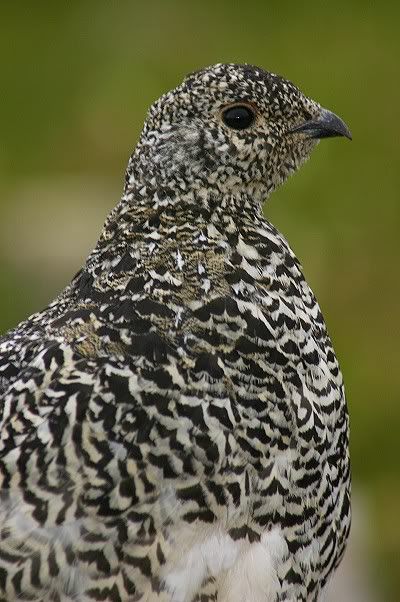 American Pipit 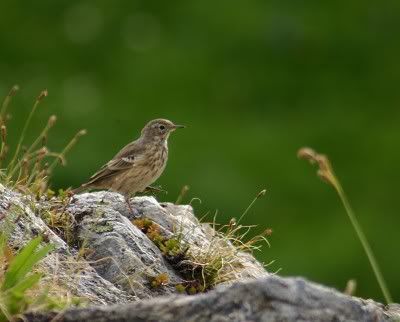 |
|
|
|
Post by JeffOver on Aug 24, 2006 16:15:15 GMT -8
Nice work on the ptarmigan, guys. Unfortunately, like Gord, I have to say I didn't see the black on the tail so I can't honestly check it off. Oh well, there'll be more times. Maybe if the winter's mild I'll try then...when they're white!!  A couple of years ago I went up Elk Mountain at the end of December, so we'll have to see. |
|
Deleted
Deleted Member
Posts: 0
|
Post by Deleted on Aug 24, 2006 20:15:41 GMT -8
Well done!! So they are still findable up there! A few of us have been starting to plan a hike for late this month, when we hope to have access to a suitable vehicle, and I've been secretly thinking the ptarmigans are probably dispersed and gone, while looking forward to a great hike anyway.
Can you tell us the approximate location you found them?
Someone posted a picture somewhere a few days ago showing the locations of the three groups of two species as found by the first group that went up, and these sites looked to me to be off the main trail a good distance. (Up and to the right from the area just beyond the Cheam-Lady notch, where the main trail heads up and to the left up the long south slope of Cheam itself)
If the reference in one message above to sitting on the side of the mountain top is literal, this would be a long way from where the first group saw them. On the other hand, some of the photos show what look like perhaps sedges that I don't recall seeing at the peak. But maybe I'm wrong on this.
Thanks guys for posting this good discussion and pics.
|
|
|
|
Post by Dave on Aug 24, 2006 20:43:59 GMT -8
The 20+ ptarmigans were all near/on the main trail near the peak of Cheam. We did a very thorough sweep of the lower mountain area (starting from the valley between Lady and Cheam) and did not find a single bird. I would advise spending the bulk of your time near the top ridge of Cheam, walking from the peak along the ridge to the west. Also, once you are on the predominately rock/shale area of the trail on the way up, focus on the eastern edge of the cheam peak. This is where we found the first male white-tails and this is where most of the birds ended up after been flooded in chickens. We did go up Lady peak a ways, but only found a few birds. Take the time to go, and post your results. Look forward to reading about them. Are you thinking of going early Saturday??? (I have 4x4  ) -Dave |
|

















 .
.


 Good work getting pictures, Dave!
Good work getting pictures, Dave!





 A couple of years ago I went up Elk Mountain at the end of December, so we'll have to see.
A couple of years ago I went up Elk Mountain at the end of December, so we'll have to see.